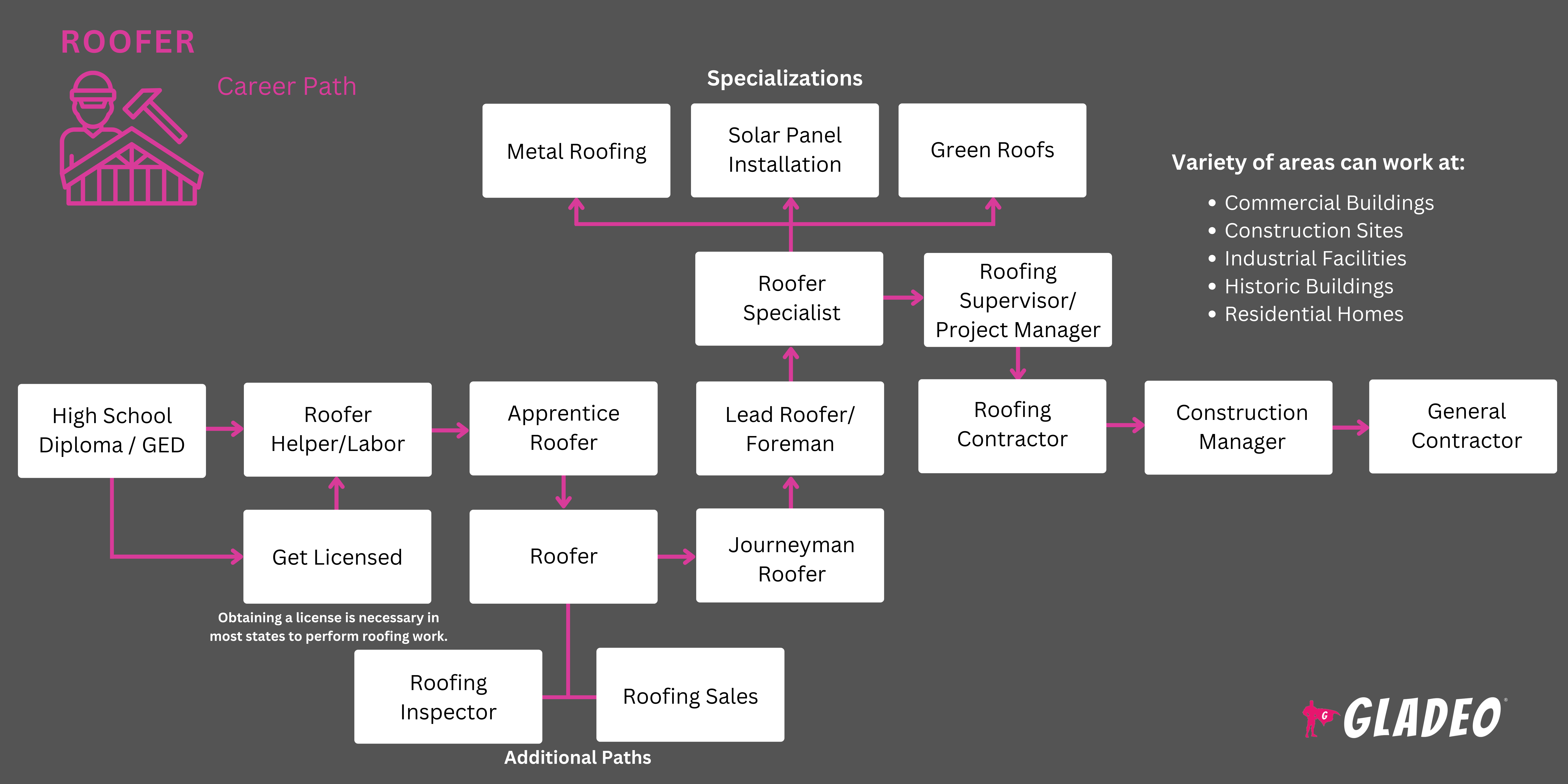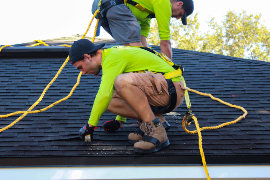聚光灯
类似标题
商业屋顶工,工业屋顶工,金属屋顶技师,住宅屋顶工,屋顶技师,屋顶服务技术员,屋顶工,屋顶技术员,金属板屋顶工
工作描述
建筑物分阶段建造,从底部地基开始,一直到墙壁、横梁和框架的其他部分。接下来是屋顶--这是密封建筑和保护内部免受风雨侵蚀的最后一道工序。屋顶不仅能遮风挡雨,还能帮助整个结构均匀分布重量,使墙体在风雪等外力作用下保持稳定。
由于屋顶需要精确性和专业性,因此这是一项由专业工人负责的工作,你猜对了,他们被称为 "屋顶工"!屋顶工使用瓦片、沥青、金属和沥青等材料,确保屋顶不受天气影响、节能、美观并符合规范。
除了安装新屋顶,屋顶工还承担着维护和修理旧屋顶的重要任务,以确保建筑物的长期耐用性。由于他们在高处工作并使用各种工具,因此安全是避免事故发生的重中之重!
职业生涯的回报
- 帮助保护家庭和企业免受气候破坏
- 户外工作和保持活跃
- 有机会专门学习不同的屋顶材料和技术
- 对节能和可持续屋顶方案的需求不断增长
内幕消息
工作职责
工作日程
屋顶工通常是全职工作,根据天气情况可能会有季节性波动。在繁忙时期或紧急维修时可能需要加班。
典型职责
- 与利益相关者会面以确定要求,例如为新建筑安装屋顶或更换(或维修)现有屋顶)。
- 审查潜在的屋顶材料、预算和项目时限。
- 注意新建筑项目的屋顶测量。根据需要测量和检查现有屋顶。
- 估算必要的工作范围,包括材料、人工和其他费用或特殊因素,如太阳能电池板安装。必要时向客户提供报价。
- 搭建脚手架和梯子,确保安全进入屋顶区域。
- 根据需要清理屋顶上的碎屑或积雪。
- 拆除旧的或损坏的屋顶材料,包括木瓦、瓦片或金属板。
- 根据需要更换腐烂或损坏的胶合板、托梁和其他结构部件。
- 安装隔汽层或隔热层,以提高能效并防潮。
- 安装屋顶通风系统,如屋脊通风口或涡轮,以改善气流和调节温度。
- 将屋顶材料与屋顶边缘精确对齐。将材料切割成适合烟囱、通风口、天窗和其他障碍物的形状。
- 使用钉子、螺丝或粘合剂固定屋顶材料。
- 在接缝和接缝处粘贴防水密封条,以实现防水密封。
- 用屋顶水泥或填缝剂覆盖外露的钉子或螺丝头。
其他职责
- 使用粉笔线或其他导线将部分重叠的屋顶材料层正确对齐。
- 使用保护涂料或薄膜来防水屋顶,防止水渍。
- 安装、维修或更换由改性塑料或弹性板等材料制成的单层屋顶系统。
- 将热沥青或焦油拖到或浇到平屋顶上,形成防水基层。
- 平整粗糙或不平整的屋顶表面,为防水处理或涂层做好准备。
- 在屋顶上安装天窗或太阳能电池板,如果经过适当培训的话。
- 在屋顶的最后一层铺上碎石或卵石,以提高耐久性。
- 指导新的屋顶工匠。了解新材料和新趋势。
工作中需要的技能
软技能
- 积极倾听
- 注重细节
- 平衡
- 喜欢攀爬和爬高
- 批判性思维
- 客户服务
- 可靠性
- 灵活性
- 独立性
- 监测
- 体力和力量
- 解决问题
- 项目管理
- 质量保证
- 安全意识
- 团队合作
- 时间管理
技术技能
- 数学,如计算屋顶面积和材料需求的基本算术,测量角度和坡度的几何,以及切割材料的分数
- 了解沥青、金属和木瓦等屋顶系统和材料
- 工具熟练程度(如射钉枪、屋顶锤和切割工具)
- 安全协议和 OSHA 标准
- 阅读蓝图,了解屋顶尺寸、角度和所需材料
- 瓦片、金属板和绝缘材料的安装技术
- 蓝图阅读
- 估算材料和成本
- 胶粘剂应用知识
- 了解木材因湿度变化而产生的移动
不同类型的组织
- 住宅建筑公司
- 屋顶承包商
- 政府机构
- 大型设施的维护部门
期望与牺牲
屋面工程可能是一项劳动密集型工作,需要搬运、攀爬和高空作业,而且经常是在炎热、寒冷或潮湿的天气条件下进行。他们必须严格遵守安全准则,防止发生事故和受伤,因此安全意识至关重要。
在冬季,降雪量大或结冰过多的地区可能会缺少工作。因此,屋顶工人可能需要提前做好财务计划,以便在这种时候能够支付生活费用。
总之,对于那些喜欢动手和户外环境的人来说,这份工作要求很高,但回报也很丰厚!
当前趋势
从事这一职业的人在年轻时喜欢做什么样的事情...
屋顶工年轻时可能喜欢动手活动、使用工具和户外项目。他们可能喜欢从事需要耐力和精确度的工作。
需要的教育和培训
- 屋顶工通常至少需要高中文凭或普通教育文凭。
- 在高中、职业学校、贸易学校或社区学院学习工具安全、建筑或屋顶技术等课程会很有帮助。
- 申请者可能需要持有有效的驾驶执照,以便能够准时到达各个工作地点。
- 在某些情况下,可能还需要商业驾驶执照(CDL)。
- 大多数有抱负的屋顶工都是从帮工做起,接受更有经验的工人的实践培训。有些人则通过受资助的学徒制边工作边学习,如屋面工、防水工及相关工人联合工会提供的学徒制。
- 雇主可能会要求新屋顶工完成职业安全与健康管理局的安全培训或GAF CARE 承包商培训中心的课程。
- 请注意,许多州都要求屋顶工在其职业生涯的某个阶段获得执照。执照选项可能包括住宅执照、商业执照或涵盖两种工作类型的组合执照。
- 要获得执照,屋顶工通常必须通过行业考试,并提供在特定时间内完成一定数量项目的证据。
- 责任保险证明和保证金是获得许可证的其他潜在要求。
- 有经验的屋顶工可以申请国家屋顶承包商协会 PROCertification计划的认证。
- 其他认证包括国际建筑围护咨询师协会的注册屋顶咨询师。
培训计划中应注意的事项
- 考虑学费、折扣和当地奖学金机会(除联邦补助外)。
- 在决定报读校内、在线或混合课程时,请考虑您的时间安排和灵活性。您需要尽可能多的实践练习。
- 仔细查看该专业的设施和设备。查看该专业教师获得的奖项和成就。
- 尝试阅读以前学生的评论。
- 查看就业统计数据和有关该计划校友网络的详细信息。
高中和大学里的事情
对于有抱负的屋顶工,这里有一份关于技能和步骤的有用指南:
- 选修相关的高中课程,如英语、普通数学(算术、分数、小数、比率、比例)、几何和物理。木工或车间课程、蓝图阅读和制图也很有价值。
- 高中生通常可以同时修读社区学院或职业培训课程。详情请咨询学校辅导员。
- 在专业屋顶工匠的指导下,学习安全使用手动和电动工具,掌握动手技能。
- 通过兼职建筑工作、初级工人职位或学徒培训获得实际工作经验。
- 通过在家里或与朋友一起完成屋顶工程来获得实践经验。
- 考虑参加人类家园等组织的志愿活动,以获得更多经验。
- 通过在线课程、教学视频或专注于建筑技能的 YouTube 频道,拓展您的屋顶知识。
- 通过与屋顶相关的书籍、杂志(如《屋顶承包商》)、博客和论坛进行自我教育。
- 询问专业屋面施工人员是否有时间进行一次信息访谈,以深入了解该行业。
- 请注意,建筑行业(包括屋顶工程)的许多雇主可能会进行就业前药物测试,以确保工作场所的安全,尤其是在使用手动和电动工具时。一些学徒或工会也可能要求进行药物测试。
典型线路图

如何找到你的第一份工作
- 在学校或通过志愿者工作、兼职工作或学徒期积累尽可能多的相关经验。
- 查看Glassdoor、Indeed、USAJOBS 或SimplyHired 等招聘门户网站。
- 在Apprenticeship.gov 上寻找学徒机会。
- 仔细筛选招聘广告,确保您符合要求。
- 例如,如果招聘广告将驾驶执照列为 "要求",您就需要在申请前取得驾驶执照。
- 如果招聘广告将拥有驾照列为 "首选 "或 "期望",您仍然可以申请,但最好让他们知道您是否正在考取驾照。
- 将简历重点放在相关的工作和学术经历上。
- 在简历/申请中加入关键词,例如
- 闪光灯安装
- 平屋顶系统
- 泄漏检测
- 金属屋顶
- 屋顶安全协议
- 屋顶检查
- 屋顶安装
- 屋顶维修
- 更换木瓦
- 防水
- 查看屋顶工简历模板,了解格式和措辞方面的想法。
- 查找常见的Roofer 面试问题。
- 向学校的就业服务人员寻求简历、模拟面试和求职方面的帮助。他们可能与当地提供学徒培训的工会有联系!
- 如果申请工会学徒,请在填写任何内容之前仔细阅读申请说明。
- 请注意,"大多数工会并不期望您在申请学徒时成为行业专家"。
- 请注意,许多技术行业的雇主在招聘过程中都会进行药物测试,以降低风险。工会学徒也可能强制要求进行学徒前药物测试或随机药物测试。
- 联系你的关系网,让他们知道你在寻找机会。
- 参与在线论坛并提出职业咨询问题。
- 询问您的教授、上司和同事是否愿意作为您的个人推荐人。
- 要想面试成功,着装一定要得体!
如何爬梯子
- 屋顶工人可以通过以下方式展现领导力:始终如一地完成高质量的工作、准时到现场、与团队成员有效合作,以及在预算范围内按时完成项目。
- 如果所在州有要求且您符合资格,请获得执照。
- 与上司谈谈你的职业目标。让他们知道,你愿意接受雇主建议的任何培训,如国家屋顶承包商协会 PROCertification或OSHA 30 小时建筑培训等热门认证。
- 考虑考取绿色屋顶、金属屋顶或商业屋顶系统等领域的专业认证。
- 参加GAF CARE 承包商培训中心的高级课程。询问有关学费报销或其他雇主赞助的教育福利的信息,以支付您继续学习的费用。
- 获得使用各种屋顶材料的经验,掌握最新技术和方法。
- 始终把安全放在首位,绝不走捷径。一次重大事故或受伤可能会毁掉你的整个职业生涯。
- 学习项目管理课程,以便更有效地处理大型项目和管理预算、时间表和人员。
- 掌握估算成本和项目投标的技能,以获得更高级职位或经营企业的资格。
- 学习防水、绝缘或太阳能电池板安装等相关行业。
- 熟悉可简化项目规划、安全合规性和客户沟通的屋面软件和技术工具。
- 建立一个专业的作品集,展示你的最佳作品、客户评价和安全记录。
- 如有必要,可考取承包商执照,以获得更多机会和更高薪酬的项目。
- 监督和指导初级屋顶工。以身作则,必要时始终佩戴个人防护设备!
- 积极参加全国屋顶承包商协会等专业组织的活动,学习知识,拓展人脉。
- 如果需要晋升,可以申请规模更大、晋升潜力更大的机构的工作,或者创办自己的企业。
推荐的工具/资源
网站
- Apprenticeship.gov
- 联合建筑商和承包商协会
- 美国总承包商协会
- 用女工技能为杰出机遇牵线搭桥
- 职业联系
- GAF
- 从头盔到防护帽
- 房屋建筑商协会
- 就业指导中心
- 全国住房建筑商协会
- 全国改建业协会
- 全国建筑业工会
- 全国屋顶承包商协会
- NCCER
- 职业安全与健康管理局
- 屋顶承包商
- 屋顶工、防水工及相关工人联合工会
书籍
- 正确的屋顶建造方法》,作者:史蒂文-博尔特
- 屋顶与护墙板完全指南》,布莱克与戴克出版社
- NRCA 屋面手册》,NRCA 著
B计划
屋顶工是建筑行业的重要成员,但并不是每个人都愿意一直在高空或户外工作。如果您考虑从事屋顶以外的工作,请参阅我们下面的相关职业列表!
- 卡朋特
- 天花板瓷砖安装工
- 建设和建筑督察
- 建筑工人
- 干墙安装工
- 电工
- 地板安装工
- 家具整饰工
- 一般维护和修理工人
- 暖通空调技术员
- 绝缘工人
- 泥瓦工
- 模型制作
- 泥水匠
- 金属板工人
- 太阳能光伏安装人员
- 金属结构制造和装配工
- 瓷砖和石材镶嵌工
- 焊工
- 木工机械安装工、操作工和调试工
新闻联播

特色工作

在线课程和工具







